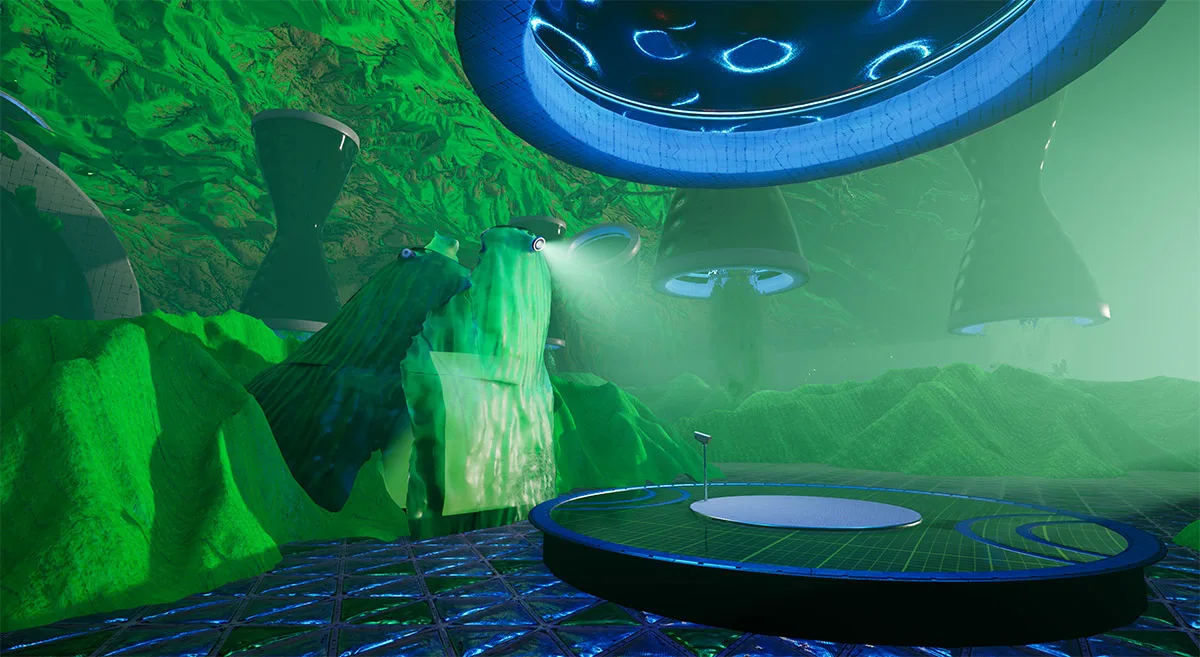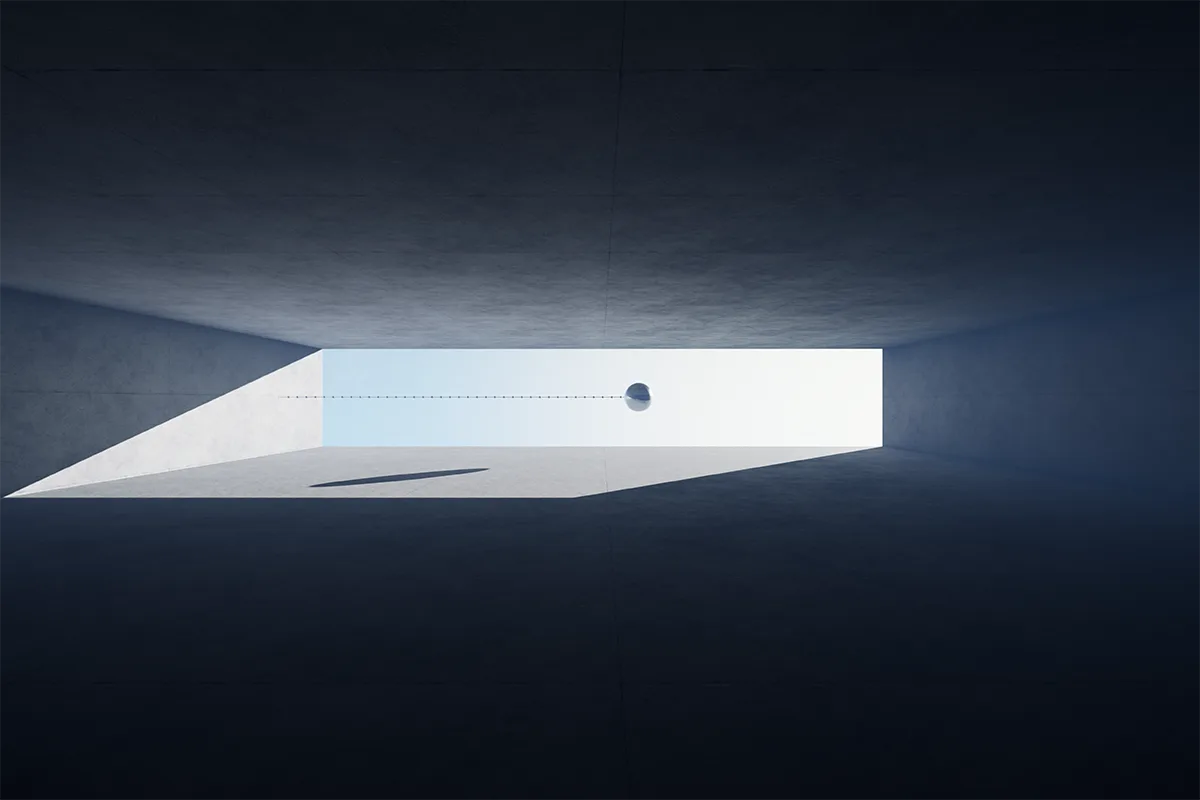
VR artist Ali Eslami began creating his project False Mirror to test out a theory about whether or not a virtual world could be habitable for humans. Alex Kahl steps into the ever-evolving world he’s spent years creating.
Sliding the virtual reality headset over your eyes in VR artist Ali Eslami’s Amsterdam studio, you’re immediately transported to another universe. You begin to move through an alien space, looking down at your blue hands, lifting your legs in a panic as you try to avoid tripping over the virtual steps that aren’t really there. You slide forwards through tunnels before floating upwards through an expansive landscape, surrounded by huge green mountains and glistening waterfalls.

This is the “Sacred Hill,” one of the many areas in False Mirror, a virtual world that invites us to leave our real lives and our physical bodies at the door and become fully immersed in it.
In 2017, Ali thought a lot about dystopian futures, wondering if humans would ever have to live their lives in a matrix-esque space that prevents us from seeing the reality around us. He considered what those virtual worlds would look like, and how we would live in them, and False Mirror was his way of exploring those questions.
He began creating a virtual world from scratch, aiming to include features and possibilities that would allow real people to live out their lives inside it. It began as one room, but has gradually grown to include multiple floors, parks, homes and characters.
In many aspects I’m jealous of kids. I think we lost a lot of things when we became adults.
In False Mirror, Ali imagines “a possible future that’s continually growing and reshaping itself.” He’d previously worked on more short-term, goal-oriented projects, but this was different. “I just wanted to have a project that I could always be working on, that could grow with my life and that could always be expanding,” he says. “In order to explore life through it, it had to be done over a long period of time.” What began as a place for play and experimentation for Ali has now become a huge, sprawling world that lives and breathes.
Growing up, gaming enthusiast Ali decided to join the so-called “modding” community, made up of people who would make their own changes to well-known games. Some of them would design their own maps or spaces within games, making their own rules to suit the way they wanted to play. A big football fan, Ali recreated the stadium from his home town in Iran and inserted it into the football game Pro Evolution Soccer, using only photos as his reference point for the design.

Ali feels the freedom of the early internet he once loved so much has been lost over time, and False Mirror is his attempt at reintroducing that sense of possibility. “The early internet was so free. Back then, you’d go from website to website and it was kind of like a journey. Now we are just exploring five per cent of the internet through social media,” Ali says. “You’re just stuck in your home algorithms, in the body that’s been defined for you, and the extent of customization they allow you is mostly just cosmetics. Freedom is so constrained. There's no room for being an alien in that.”
Ali created False Mirror as a speculative test rather than a game. “It's a collection of spaces and bodies that are designed to be lived in, to explore whether or not we could live virtual lives,” he says. Ali asks some philosophical questions as he works on the project, and one that comes to mind with False Mirror is: what constitutes an identity? Since he wants to test whether people could live their entire life in this world, he has to consider what they actually require to be “people,” and one key thing that makes someone who they are is their past, or their memories.
Memories play a big role in False Mirror, especially so in one of the more eerie spaces in the project, named Escapement. Thousands of tiles cover every surface of the room, and the user is given a ball to hold. Each time the ball hits a tile, the sound of a “memory” is played. Different voices saying things like “Farewell,” “I love you,” or “It was just a dream.” Some of the memories are the sounds of people laughing or crying. Ali recorded each “memory” from random YouTube videos and podcasts. On their own they’re abstract soundbites, but in this room they could easily be snippets from a person’s past.
Theoretically, if someone were to grow up in False Mirror, these random memories could be implanted into them, giving them the feeling that they’ve lived a full and busy life in the real world. The inclusion of memory means the world has more chance of feeling real to a user, and Ali has created some characters to simulate how it might look for a person to live in it.
In today’s internet landscape, freedom is so constrained. There’s no room for being an alien in that.
There are currently two characters in the project, Alless, a human-like figure, and Lena, a floating being with flowing branches and roots for hands. Everywhere Lena goes, she leaves behind a trail of levitating stones, supposedly her memories. Meanwhile, Alless carries with him a hoover that examines everything it sucks into its pipe, analyzing and defining it. Alless and Lena met one another in a recent video released by Ali. As entirely different types of being, Alless initially cannot see Lena, but he can see the memories she leaves behind her, which he vacuums as Lena gradually becomes visible to him.
The characters’ human qualities and interactions make the world feel more familiar to us as we watch it, and the role that sound plays in the experience only makes the park seem more real. Ali works with a sound designer to get every little noise just right. From the ASMR-like whispers you hear in the Escapement room to the uncomfortable creaking coming from the chair that hangs by a noose. An ambient soundtrack plays in the background throughout your travels. It’s an incredibly sensory experience, and this means it can often be meditative to explore.

Ali said on the Voices of VR podcast that he surprised himself at how some of the spaces he’s created in False Mirror can function in a similar way to their real life equivalents. Sitting in or wandering through one of his virtual parks with no purpose, no activity, no objective, Ali could zone out and relax just as he would in a real park.
“I had a real sense of frustration with the gaming world, because people think every game needs to have a purpose, and if there's no purpose, people feel like the game is somehow unfinished,” he says. For this reason, False Mirror is far from a “game.” Most of its spaces just “are.” They don’t offer much interaction and when they do, the experiences are often there to offer the user an experience, rather than an objective.
Exploring this rapidly-growing open world, bouncing a memory ball on the ground, and planting flowers in mid-air, it’s a calming, meditative experience that feels truly free. With no people around, it’s a chance for the user to connect with and live amongst inanimate objects, which is something Ali enjoyed as a kid.
“I had an obsession with space and objects. I could connect with a keychain for hours, just enjoying the silly noises it would make,” he says. “I think that in many aspects I'm jealous of kids. I think we lost a lot of things when we became adults. But in VR, in False Mirror, I found that space again.”

